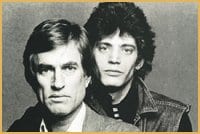The first time James Crump heard of Sam Wagstaff, he had no idea who Wagstaff was.
“I’d gone to Robert Mapplethorpe’s exhibition at the Whitney in 1988,” Crump recalls, “and there’s a really very compelling photograph of Sam with his arms crossed, and he’s looking to the left, I think. It’s probably the best portrait of him ever taken by Robert; it’s at the height of his prowess, of his masculinity, of his looks, and it underscored everything about him.
“When I first saw it, it just resonated for a really long time. That’s when I started asking, ‘Who is Sam Wagstaff?'”
Wagstaff’s contribution to both the arts and to Mapplethorpe’s career has largely been neglected. “I don’t think that was a conscious omission on anyone’s part,” Crump informs me by phone, “except perhaps the mythmakers of Robert Mapplethorpe.
“But now that Sam’s on the radar, there’s been a significant amount of interest,” Crump says, from both the fine arts world and the gay community —largely thanks to his new documentary, Black White + Grey.
A former curator of the Wadsworth Atheneum and the Detroit Institute of Art, Wagstaff championed abstract expressionism and minimalism, and had a lasting impact on the careers of artists like Tony Smith. When he came into money in the 1970s, Wagstaff used it to amass a vast photography collection —the eventual sale of which, to the Getty Museum for $5 million dollars, would do a great deal to raise the profile of photography as a fine art form and collectible.
In 1972, Wagstaff met, fell in love with, and did a phenomenal amount to support a young, relatively unknown, and very hungry photographer 25 years his junior, with whom he happened to share a birthdate.
Wagstaff bought Mapplethorpe a loft and helped promote and shape his work, remaining his lover, patron, and friend for many years.
When Wagstaff died of AIDS in 1987, he left the vast bulk of his wealth to the photographer, who used it to set up the Robert Mapplethorpe Foundation.
Mapplethorpe died of AIDS himself two years later.
Wagstaff’s contribution to Mapplethorpe’s career has been so neglected that various people interviewed for the film disparage Mapplethorpe in favour of Wagstaff. Writer and art historian Eugenia Parry, who did graduate work with Crump, is particularly harsh.
“Mapplethorpe didn’t love anybody but himself,” she says in the film. “He saw in Sam a rich guy who could help promote his tastes and his art. What a little nelly Sam became when Mapplethorpe was around! Sam shrunk down to a little walnut-sized guy. Sam was all too willing to cede to Mapplethorpe, because Mapplethorpe was the artist.”
Crump disagrees with this as a final assessment of their relationship, though.
“Mapplethorpe was able to benefit from Sam’s affluence, there’s no doubt about that. I think from the outside people see that —that’s the thing that stands out the most. But Robert, he gave a lot to Sam too.”
Crump sees Wagstaff who, coming from an old money background, was closeted through the 1950s, as “relishing” his discovery of a liberated sexuality with Mapplethorpe, “rolling in it, feeling very emboldened by it… I actually think that they both enabled each other. That’s the word I like to use.
“I think, if anything, the relationship was mutually exploitative. Meaning that Sam took from Robert things that he needed. He took agency in some of the darker realms [of sex clubs, transgression, and sadomasochistic play]. And Robert conversely was given agency in the art world, and in social realms that he doesn’t have access to.
“I think they’re giving each other different, complimentary things. I don’t know that it’s unequal from a power sense. I think, actually, it’s pretty balanced.”
I ask Crump if he thinks that, in his support of Mapplethorpe and other controversial artists, Wagstaff was trying to loosen up an oppressive status quo and create more room for gay men, and thereby himself.
“I think that Sam probably would have been interested in that, or he wouldn’t have been averse to it,” Crump acknowledges. “But I think more importantly, Sam enjoyed playing the role of provocateur. He enjoyed pushing buttons.”
Some reviewers have found the film a little too dramatic in its treatment of the “darker” aspects of Wagstaff’s personality, but Crump means no censure; he is merely “trying to explain or explicate the aesthetics of a personality and where they come from, and how it’s very complex.
“If you look at the Mapplethorpe pictures and you look at the Civil War era photographs, and the travel photographs, and some of the more difficult images that are part of Sam’s collection —the medical photographs —it begins to tell you the story of the aesthetics of an eye. To me, that ties together with these other things; with this interest in exploring personal aspects of oneself through drugs, through sex, through spiritual means, and pushing the envelope to get to a core state.”
Alas, Wagstaff’s most sexually explicit photos —and the more famously confrontational Mapplethorpe images of golden showers, bondage, and anally-inserted bullwhips —are left out of the film, so as not to limit its market.
Viewers hoping for an intimate portrait of the gay scene in New York in the 1970s may also be slightly disappointed by the film; Crump, in keeping with his own background as a photography editor and his agenda to “place Sam Wagstaff into the greater historical context of the art world and culture and general,” is much more interested in following Wagstaff into photography auctions than into bars like the Meat Rack.
Still, Black White + Grey is a tantalizing and information-rich portrait of a unique relationship, and an unfairly neglected and fascinating man.

 Why you can trust Xtra
Why you can trust Xtra


